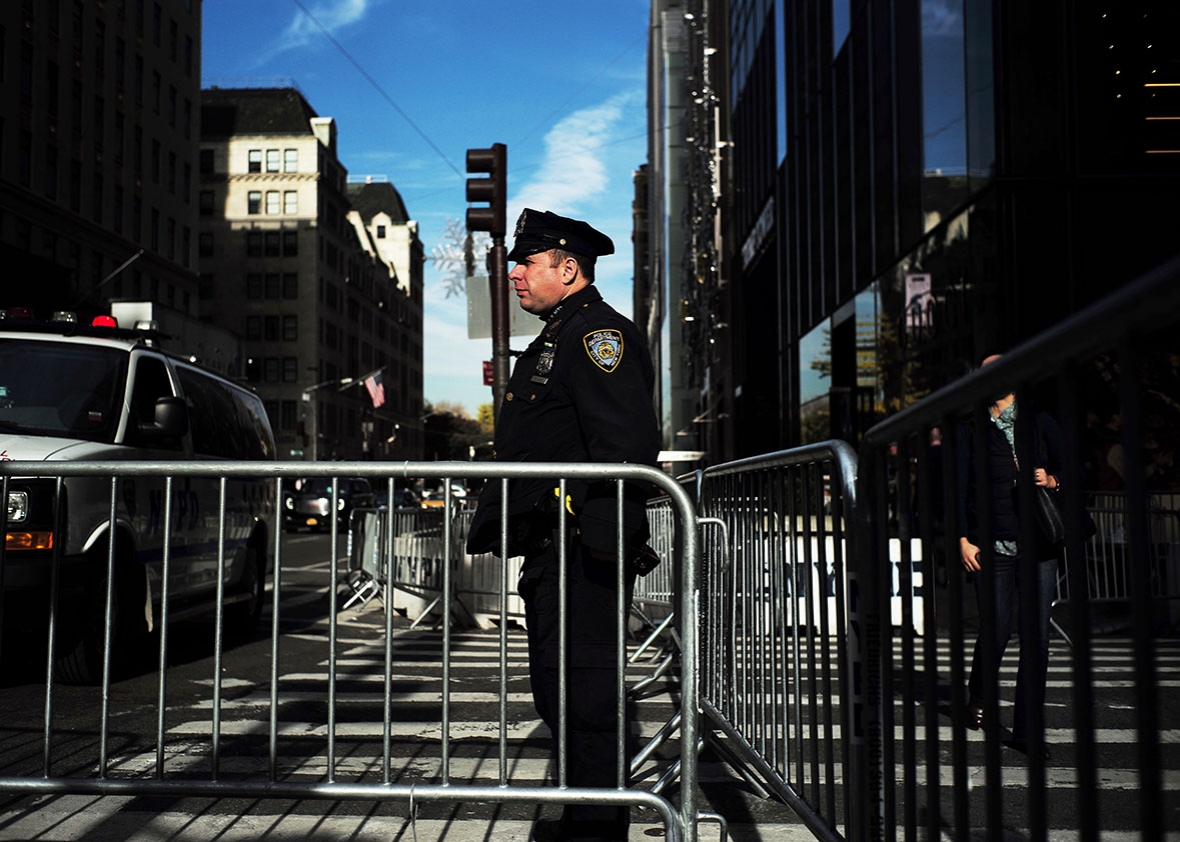Not in Our Town
Can American cities stop Trump from deporting millions?

Lucas Jackson/Reuters
From the day he announced his campaign and called Mexicans “rapists” through 17 months of promises to erect his big, beautiful wall, Donald Trump made contempt for immigrants a central theme of his campaign. Friday brought news that Trump plans to nominate Sen. Jeff Sessions, who enjoys a reputation as the most anti-immigration U.S. senator, as attorney general. And the previous Sunday, in an interview on 60 Minutes, the president-elect told Lesley Stahl that one of his first priorities in office would be the immediate deportation of 2 million to 3 million undocumented immigrants with criminal records. (Most advocates say there are at most 800,000 such people.)
Big-city officials had an immediate response: not with our help. Last Monday, Los Angeles Police Chief Charlie Beck said his department would not assist the Trump administration with deportations. Chicago Mayor Rahm Emanuel said his city “is and will remain a sanctuary city.” A handful of other mayors, including those of New York; Oakland, California; Minneapolis; San Francisco; and Seattle, also pledged that they would not relinquish their status as sanctuary cities, places that in some way decline to put their powers in the service of U.S. Immigration and Customs Enforcement. In the 100-day action plan his transition team released, Trump has promised to block all federal funding for such places, which, depending on how you define sanctuary cities, may number as many as 400. That pledge sets Trump up for a showdown with local officials, including police chiefs and sheriffs, who say aggressive immigration enforcement isn’t compatible with good policing. And it places cities at the frontlines of the resistance against the incoming administration’s policies.
This conflict goes back two decades. Many of the so-called sanctuary cities were indispensable partners in the enormous wave of deportations that surged in the George W. Bush era and peaked, under Obama, with the eviction of more than 400,000 people in fiscal year 2012. The following year, local law enforcement initiated more than half of all nonborder deportations. Now, most large jurisdictions—even those that do not label themselves as sanctuaries, such as Philadelphia, which considers itself a “Fourth Amendment city,” a municipality that protects against unreasonable searches and seizures—will no longer commit their police to federal immigration work. Hundreds of U.S. jurisdictions, including cities, counties, and whole states, are exhibiting some form of noncompliance with federal immigration authorities.
“Local law enforcement is not going to do the job of the federal immigration agency,” Denver Mayor Michael Hancock told me. “It’s not our responsibility.” Denver doesn’t have a formal policy of noncooperation with federal immigration authorities, but it refuses to unlawfully detain suspected undocumented immigrants without warrants. For some jurisdictions, resisting ICE is about limited resources. For others, it is a political, ethical, or economic stand. For nearly all of them, rejecting federal entreaties to find, hold, and hand over undocumented immigrants is considered a requirement of effective urban police work.
This is not a new phenomenon. New York City had a law prohibiting city employees from reporting to federal immigration authorities until Congress pre-empted it in 1996. Then-Mayor Rudy Giuliani, of all people, fought for the city’s law in court and lost. “We can remind people that no one is required to turn in the names of illegal aliens,” he said at the time, “and we can encourage people not to do that.” But even though cities can no longer mandate “don’t tell” provisions, they can still adopt “don’t ask” and “don’t enforce” rules, and so they have.
Today, the nation’s three biggest cities, New York, L.A., and Chicago, alone account for about 2 million of the undocumented residents who help make up the fabric of American life. Can cities—and the hundreds of other jurisdictions that have some kind of explicit sanctuary policy—serve as a bulwark against a Trump administration pushing to deport millions? The answer is almost certainly yes. The question is what it will cost them.
* * *
ICE divides deportations into two categories: border and interior. The former is straightforward: Agents apprehend entrants on the coastlines, at airports, and in the desert around the southern border with Mexico. The latter is much more complicated. Once immigrants have integrated into society, their evictions are harder to achieve—in part because they’re harder to justify: They have homes, jobs, children, and communities.
For years, immigration enforcement was the purview of the federal government, which managed to deport tens of thousands each year. Then came the 1996 immigration bill, which gave immigration officials vast powers and expanded the types of crimes that enabled detention. Annual deportations leaped from 70,000 in the 1996 fiscal year to nearly 200,000 two years later. The law also deputized local law enforcement as immigration police. In the wake of Sept. 11, 2001, dozens of jurisdictions signed up, which helped the Bush administration deport 200,000, and then 300,000, and finally nearly 400,000 people a year during his terms. Under a 287(g) agreement, counties such as Texas’ Harris (which includes Houston) and states such as Florida opted to make their cops into the eyes and ears of ICE, changing the nature of police work. The largest local collaborator was Arizona’s Maricopa County, home of Phoenix, where Sheriff Joe Arpaio waged a yearslong campaign of intimidation, harassment, and racial profiling against immigrants. (The Department of Homeland Security rescinded the agreement with Maricopa County in 2010.)
This was a crucial factor in the linear growth of deportations under Bush. ICE is the largest investigative agency in DHS and employs about 6,000 enforcement officers. But its numbers are tiny compared with the nation’s full-time law enforcement officers, who numbered about 725,000 in 2013.

Jewel Samad/Getty Images
In 2008, at the recommendation of the 9/11 Commission, the Bush administration introduced a new information-sharing program called Secure Communities. The idea was simple: Any time a participating jurisdiction took fingerprints, it sent them to the FBI. Now, those prints would also be checked against a DHS database. If DHS found someone it suspected could be deported, the agency issued a detainer request. Flagged individuals would then be held in local jails until ICE could arrive and place them in federal custody. Some saw a judge, some didn’t. Few had legal representation. Between 2011 and 2013, when the program was at its peak, S-Comm led to 243,000 deportations—about 40 percent of the total interior removals.
In 2011, states and cities began to withdraw from the program. Part of municipalities’ reluctance stemmed from the human cost of complying with ICE. Jobs were lost and families ruined over minor offenses. Between 2007 and 2012, for example, 260,000 noncitizens were deported for drug possession. Through 2011, according to ICE, more than half of those deported through S-Comm either had no criminal record or had been convicted of minor offenses like traffic violations.
The economic impact of deportations was also becoming obvious, especially in small towns. Postville, Iowa, lost a fifth of its residents over a few hours when 1,000 DHS agents raided the nation’s largest kosher meatpacking plant. The company filed for bankruptcy. The raid cost $5 million.
Perceived as agents of ICE, local police officers were met with growing distrust in Hispanic neighborhoods by both legal and illegal immigrants. A survey of Latinos in Chicago, Houston, Los Angeles, and Phoenix—four of the nation’s largest Latino population centers—found that 44 percent of Latinos were less likely to contact the police when they were the victims of crimes for fear of ensuing investigations. Even among citizens of Latino origin, nearly a third were less likely to contact the police for fear that cops would use the interaction to investigate their family, friends, or neighbors. The President’s Task Force on 21st Century Policing, a report released last year, recommended DHS terminate its reliance on state and local criminal justice.
Finally, the policy had a dubious legal foundation. By detaining people on the word of ICE, cities made themselves vulnerable to Fourth Amendment lawsuits. In 2014, a handful of federal district courts concluded that local police would be liable for civil rights violations for heeding ICE detainer requests without warrants.
Three things changed in Obama’s second term that conspired to send deportation numbers plummeting to a 10-year low. The Obama administration replaced S-Comm with a less stringent protocol. DHS Secretary Jeh Johnson declared a new focus on high-risk individuals. And local resistance flourished.
A crucial question heading into the Trump administration is this: To what extent did local noncompliance precipitate the deportation decline?
When the Obama administration ditched S-Comm, its replacement was a more flexible system called the Priorities Enforcement Program. In some cases, instead of asking local authorities to detain immigrants until they could be picked up, ICE started asking to know release dates. This decreased cities’ liability for complying, and DHS was able to boast that dozens of sanctuary jurisdictions had come back around. It also allowed both federal enforcers and cities to claim victory. Under PEP, only a small percentage of detainer requests are rejected. At the same time, many fewer requests are made. Many advocates, however, saw little difference between S-Comm and PEP and doubted the administration’s claim to be focused on more serious criminals.
Still, deportations fell rapidly. Apprehensions at the border now account for more than two-thirds of deportations, up from about one-third in 2008. The number of ICE deportations that start in the interior and evict U.S. residents has fallen by 70 percent since 2009. Hard-liners see the shift as a concession and a result of a policy that’s a poor, porous substitute for S-Comm.
Trump, among others, has called for S-Comm to be reinstated.
* * *
Now the immigration hard-liners have taken over. And we’re about to find out if ICE has really been stymied by the sanctuary movement.
Local resistance to S-Comm posed a “significant challenge,” ICE Director Sarah Saldaña testified last year. But because the backlash to ICE pressure coincided with a vocal realignment of federal priorities—the emphasis on serious criminals, plus PEP—it’s hard to pinpoint how many deportations were avoided because of local noncompliance and could be avoided in the future. Some scholars believe the anti-detainer policies helped change federal policy. Others aren’t so sure.
“If the main reason for that drop is state anti-detainer policy, then a huge amount depends on state resistance,” said Adam Cox, a professor at New York University Law School. If, on the other hand, detainers and deportations have fallen because of federal priorities, cities and states may not have played so great a role in sending the numbers down—and may not be able to offer substantive reprieve in a Trump administration. Trump could immediately direct ICE to aggressively pursue detainers for individuals with nonviolent offenses like marijuana possession or illegal re-entry on their records.

Robert Galbraith/Reuters
But forcing cities and states to participate will be more difficult. Thanks to a 1997 Supreme Court case (over, of all things, federally mandated background checks for gun sales), local police can’t be dragooned into doing Washington’s work. On the campaign trail, Trump promised to get noncompliant jurisdictions on board. But if the past decade is any guide, local police will resist any stricter policy. Major city police chiefs have repeatedly stated their opposition to enforcing federal immigration law.
They were once the single most important funnel of immigrants into detainment, according to Muzaffar Chishti of the Migration Policy Institute. “I don’t know of a single major city police chief that does not abhor the general entanglement of federal immigration enforcement and local police,” he said. Chishti is optimistic that local authorities can effectively slow a deportation push by Trump.
But while Congress almost certainly cannot force local cops to hold suspects, it can withhold funding—a common way to avoid violating the 10th Amendment, which gives power not explicitly held by the federal government to the states. Trump has said he will cut all federal funding from sanctuary cities as a threat to ensure compliance, taking up a threat that congressional Republicans made last year after a San Francisco woman was murdered by an undocumented immigrant with a criminal record whose detainer request had been ignored by the county sheriff’s department.
The version of that bill that was proposed by Sen. Pat Toomey of Pennsylvania this summer would have cut two types of federal grants to sanctuary jurisdictions, amounting to a penalty of about $700 million, collectively, on the 10 largest noncompliant localities. That is a small portion of the money cities receive from the federal government but would still put local authorities in a difficult position.
Trump can take action elsewhere, of course. The president can reverse President Obama’s 2012 executive action that created Deferred Action for Childhood Arrivals, which allowed so-called Dreamers, who were brought to this country as children, to receive deportation protection and work permits. About 750,000 have been approved. Their information is also in a federal database, putting them at risk under a Trump administration.
Trump’s attorney general—whether it ends up being Sessions or someone else as eager to crack down on undocumented immigrants—could do a wide number of things: Support hostile immigration judges, as Bush Attorney General John Ashcroft did, or tighten asylum rules, or decline to investigate reports of civil rights violations like those that occurred in Maricopa County under Arpaio. He could sue cities with soft “don’t tell” policies, which may violate a section of federal law but have rarely been contested in court. Trump could also try to make good on his campaign promise to triple ICE’s manpower, creating a “deportation force.” House Speaker Paul Ryan has said that is not on the table.
If there is a barrier to Trump resurrecting the massive deportations of the Bush and Obama years, though, it lies in the independence of local law enforcement. To override them is certainly possible. But it would require a vast expansion in federal power that, under any other circumstances, would be anathema to small-government conservatives worried about Washington overreach and rejecting the judgment of local police. The self-proclaimed law-and-order candidate would have to act against the wishes of police chiefs. Trump couldn’t persuade voters in those places to support his candidacy. How much punishment is he willing to inflict on them to ensure they assist in an unprecedented eviction of the American populace?
